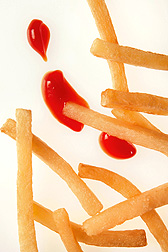Better French Fries: Technique Helps Lower Fat
|
|
No doubt about it. Americans love French fries.
But fries soak up a lot of oil while they’re turning a perfect golden brown in the deep-fat fryer.
Agricultural Research Service scientist Zhongli Pan and colleagues have tackled the challenge of lowering some of the fat from this favorite side order without skimping on the fries’ delicious taste and texture or their pleasing appearance and aroma.
Their idea?
After potatoes are peeled and sliced into strips, and just before the raw strips are dunked in the fryer, prep them with 3 minutes of infrared (IR) heat—just like that created in home or commercial IR ovens or grills.
The IR prep “forms a nice, microscopic crust on the fries, which helps reduce oil uptake,” says Pan, an agricultural engineer at the ARS Western Regional Research Center in Albany, California.
His team has made hundreds of fries—about 20 pounds in all—to determine the best combination of IR heating times and intensities, and deep-frying times and temps, to produce appetizing fries with less oil.
|
|
In these experiments, Pan’s group used an IR unit with emitters that heated the top and underside of the fries, each a square-cut strip about 3/8-inch by 4 inches.
Fries that were prepped with 3 minutes of infrared at 120 kilowatts per square foot, then deep-fried at about 295°F for 7 minutes, had about one-third (37.1 percent) less oil than fresh-cut fries that were not prepped with IR heat.
What’s more, an IR unit that heats all surfaces of the fries—not just the top and bottom—might lower the fries’ fat content even further, according to Pan.
Of the 77 volunteer taste-testers who sampled the fries, more than half said they found the taste and color of the IR-prepped fries to be no different from that of the conventionally prepared fries. More than half of the panelists said they preferred the IR fries’ crunchier texture.
“Fresh fries” are prepared from start to finish while you wait, instead of being prepared from a frozen product. Though the team has only published oil uptake comparisons for IR-prepped vs. non-IR-prepped fresh fries, the IR prep is also suitable for fries that are partially processed at a potato-processing plant, says Pan.
Typically, partially processed fries are blanched with steam or hot water for about 14 minutes to inactivate enzymes—like polyphenol oxidase—that might otherwise cause unwanted browning.
After that, the fries are air-dried for about 5 minutes, then partially fried, called “par-frying,” for about 1 minute, before they are packed, frozen, stored, and then shipped for finish-frying at restaurants, cafeterias, and other eating places.
IR heating can make this process simpler, faster, more environmentally friendly, and perhaps less expensive, as well, notes Pan. That’s because IR blanches the potato strips, and clobbers those enzymes, without using water. So there’s no need for air-drying. Processors who opt for IR prep may be able to reduce water use and cost—and perhaps lower their energy bills, too.
The idea of prepping fries to help reduce oil uptake isn’t new. But the experiments that Pan led are apparently the first to as extensively explore IR as a prepping option for fresh or finish-frying of French fries.
The team’s findings are documented in a peer-reviewed scientific article published in 2012 in Food Chemistry. Pan collaborated in the work with Tara H. McHugh, food technologist and leader of the Processed Foods Research Unit, to which Pan belongs; Gokhan Bingol, formerly at the Albany center; and Ang Zhang of Northwest A&F University, Yangling, Shaanxi, China.
ARS and the Washington State Potato Commission funded the research.—By Marcia Wood, Agricultural Research Service Information Staff.
This research is part of Quality and Utilization of Agricultural Products, an ARS national program (#306) described at www.nps.ars.usda.gov.
Zhongli Pan is with the USDA-ARS Western Regional Research Center, 800 Buchanan St., Albany, CA 94710; (510) 559-5861.
"Better French Fries: Technique Helps Lower Fat" was published in the July 2013 issue of Agricultural Research magazine.








